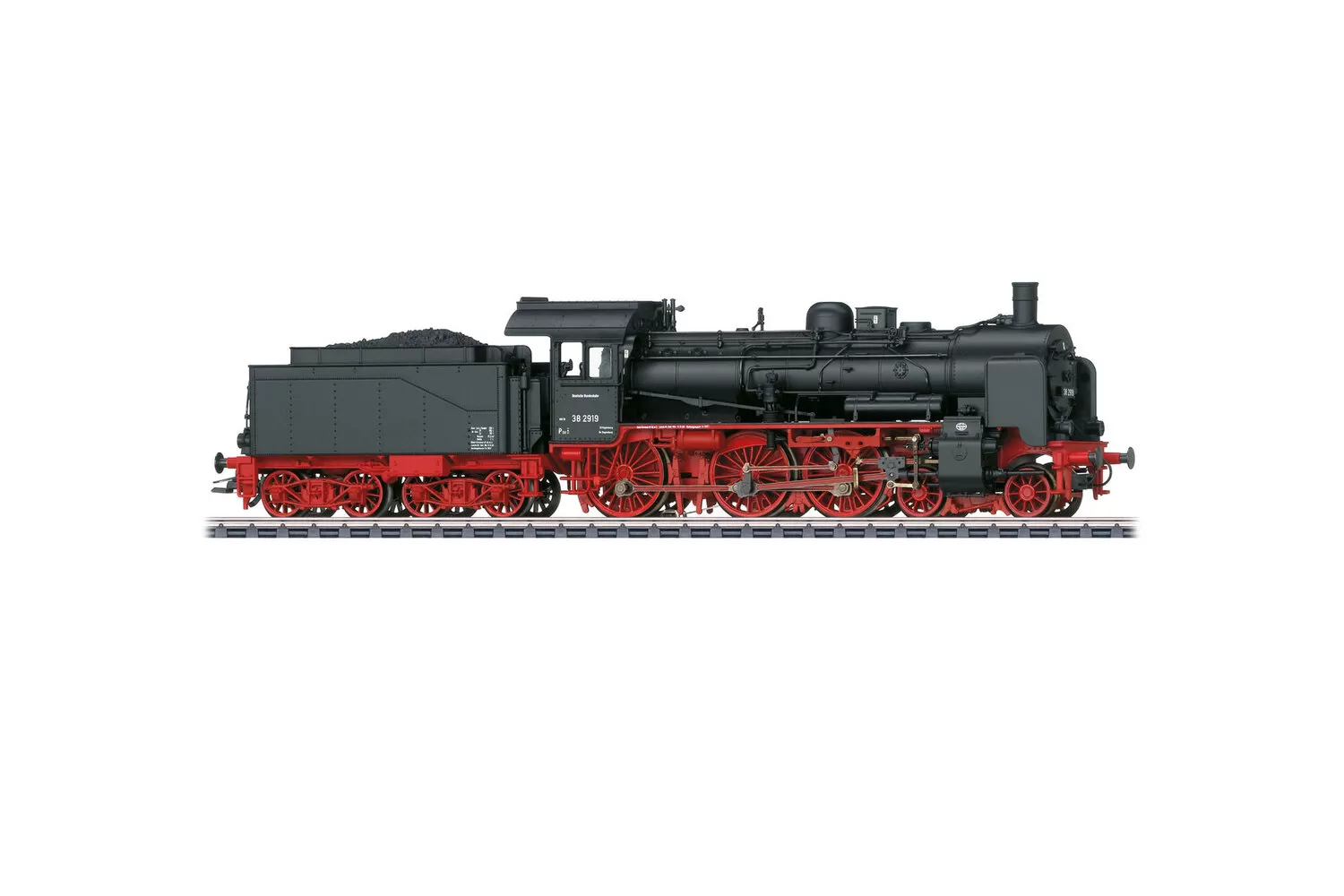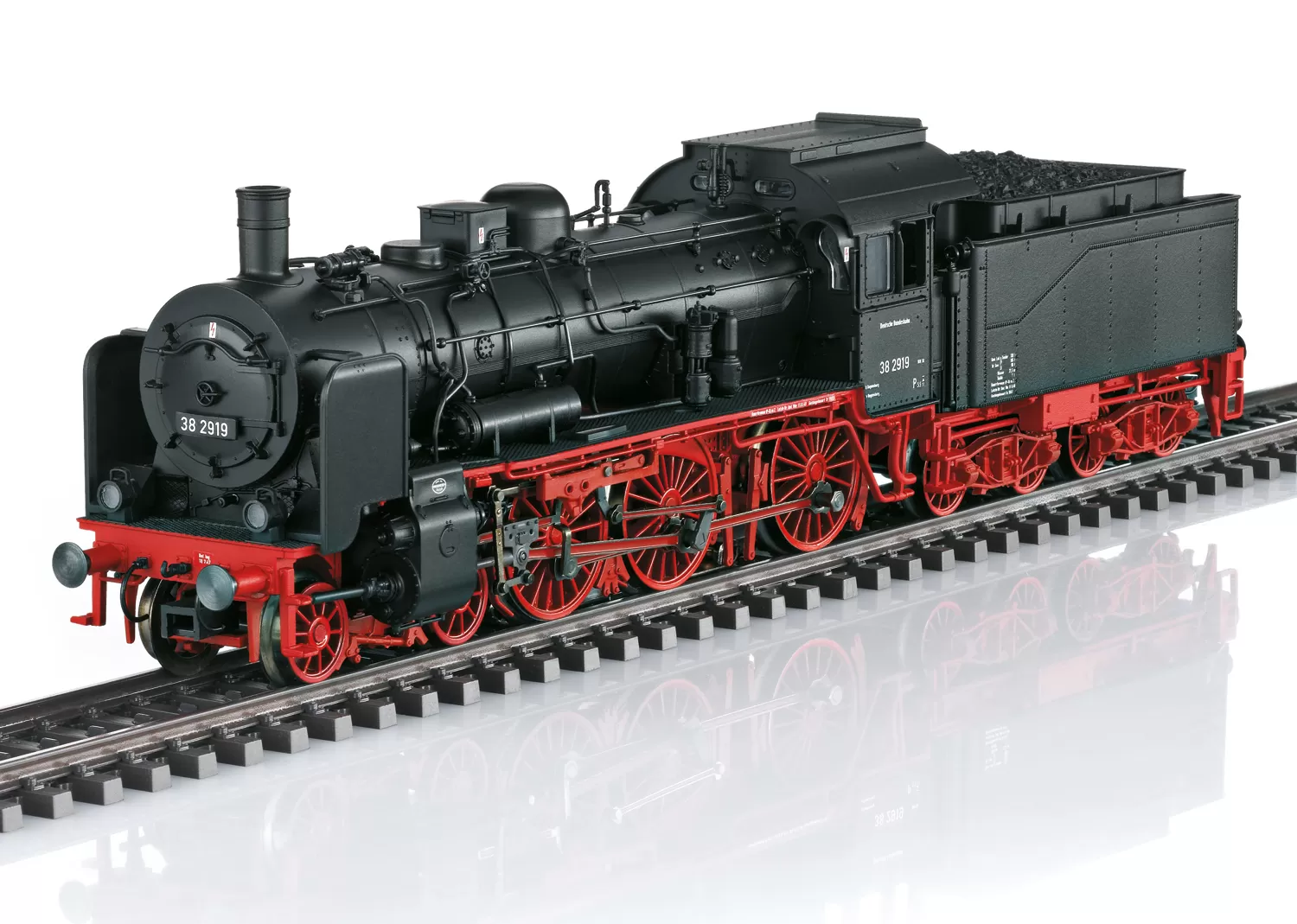
Source: maerklin.de

Source: maerklin.de
DB - Class 38 steam locomotive
A Locomotive with a Unique History
This class 38.10-40 with builder number 3676 and built in 1921 achieved many years of service to enter the history of German railroad technology in 1951 as the legendary experimental locomotive, road number 78 1001. Road number 38 2919 is being presented as new tooling for the class 38 at the end of its service life in 1950 based in Regensburg. It is being modelled for the first time as a Märklin H0 model. The front of the locomotive is prototypically on target with the DRB lanterns typical for early Era III and small Wagner smoke deflectors. The arrangement of the boiler fittings with the steam dome, sand box, and feed water purifier is modelled as exactly as possible from the prototype. This also applies to the fine spoked wheelsets on the locomotive and tender. The mostly metal construction provides very good running characteristics for the model and its impressive pulling power is thanks to a powerful motor mounted in the boiler. Even if the P 8 with over 3,900 units is one of the most successful locomotives in railroad history and resulted in many railroad models, this class 38 is a must on every model railroad layout because it has its own quite exciting history.
Prototype: German Federal Railroad (DB) class 38.10-40 steam locomotive with a tender. Former Prussian P8. Version with two boiler domes, small Wagner smoke deflectors, and a box-style tender. Road number 38 2919. The locomotive looks as it did around 1949/50.
Highlights:
- boiler fittings: one of the striking features is the boiler fittings with a steam dome, sandbox, and feed water purifier;
- lanterns: to go with early Era III, the model still has two typical German State Railroad lanterns front and rear;
- small details: steam lines, lines, whistle, generator and safety valves separately applied;
- motor: motor includes a flywheel in the boiler. Drive mechanism by means of a worm / spur gear drive in the running gear on the first driving wheelset;
- aerodynamics: small Wagner smoke deflectors;
- coupler: operating, current-conducting coupler, can be controlled digitally;
- sanding pipes: prototypical sanding pipes;
- smoke box door: smoke box door includes central locking device and number board beneath the center;
- P8 cab: open Prussian design class P8 cab with a ventilation cupola;
- wheelsets: finely spoked wheelsets with the correct diameter, also the pilot wheels; small flanges;
- spoked wheels: the spoked wheels in the arch bar trucks on the type 2‘2‘T21,5 tender merit special attention;
- tender: type 2‘2‘ T21,5 tender with arch bar trucks with spoked wheels;
- lighting: cab lighting and flickering light in the firebox;
- feed pump: knorr design simple feed pump on the left running board.
Model: The locomotive has an mfx+ digital decoder and extensive sound functions. It also has controlled high-efficiency propulsion with a flywheel, mounted in the boiler. 3 axles powered. Traction tires. The locomotive and tender are constructed mostly of metal. Dual headlights change over with the direction of travel, will work in conventional operation, and can be controlled digitally. The smoke unit contact will work in conventional operation and can be controlled digitally. The 72270 smoke unit can be installed in the locomotive. The flickering of the fire can be controlled digitally. In addition, the cab lighting can be controlled digitally. Maintenance-free warm white LEDs are used for the lighting. There is a current-conducting close coupler on the tender that can be controlled digitally. The minimum radius for operation is 360 mm / 14-3/16". Protective piston rod sleeves, brake hoses, and prototype couplers are included.
Length over the buffers 21.3 cm / 8-3/8".
This class 38.10-40 with builder number 3676 and built in 1921 achieved many years of service to enter the history of German railroad technology in 1951 as the legendary experimental locomotive, road number 78 1001. Road number 38 2919 is being presented as new tooling for the class 38 at the end of its service life in 1950 based in Regensburg. It is being modelled for the first time as a Märklin H0 model. The front of the locomotive is prototypically on target with the DRB lanterns typical for early Era III and small Wagner smoke deflectors. The arrangement of the boiler fittings with the steam dome, sand box, and feed water purifier is modelled as exactly as possible from the prototype. This also applies to the fine spoked wheelsets on the locomotive and tender. The mostly metal construction provides very good running characteristics for the model and its impressive pulling power is thanks to a powerful motor mounted in the boiler. Even if the P 8 with over 3,900 units is one of the most successful locomotives in railroad history and resulted in many railroad models, this class 38 is a must on every model railroad layout because it has its own quite exciting history.
Prototype: German Federal Railroad (DB) class 38.10-40 steam locomotive with a tender. Former Prussian P8. Version with two boiler domes, small Wagner smoke deflectors, and a box-style tender. Road number 38 2919. The locomotive looks as it did around 1949/50.
Highlights:
- boiler fittings: one of the striking features is the boiler fittings with a steam dome, sandbox, and feed water purifier;
- lanterns: to go with early Era III, the model still has two typical German State Railroad lanterns front and rear;
- small details: steam lines, lines, whistle, generator and safety valves separately applied;
- motor: motor includes a flywheel in the boiler. Drive mechanism by means of a worm / spur gear drive in the running gear on the first driving wheelset;
- aerodynamics: small Wagner smoke deflectors;
- coupler: operating, current-conducting coupler, can be controlled digitally;
- sanding pipes: prototypical sanding pipes;
- smoke box door: smoke box door includes central locking device and number board beneath the center;
- P8 cab: open Prussian design class P8 cab with a ventilation cupola;
- wheelsets: finely spoked wheelsets with the correct diameter, also the pilot wheels; small flanges;
- spoked wheels: the spoked wheels in the arch bar trucks on the type 2‘2‘T21,5 tender merit special attention;
- tender: type 2‘2‘ T21,5 tender with arch bar trucks with spoked wheels;
- lighting: cab lighting and flickering light in the firebox;
- feed pump: knorr design simple feed pump on the left running board.
Model: The locomotive has an mfx+ digital decoder and extensive sound functions. It also has controlled high-efficiency propulsion with a flywheel, mounted in the boiler. 3 axles powered. Traction tires. The locomotive and tender are constructed mostly of metal. Dual headlights change over with the direction of travel, will work in conventional operation, and can be controlled digitally. The smoke unit contact will work in conventional operation and can be controlled digitally. The 72270 smoke unit can be installed in the locomotive. The flickering of the fire can be controlled digitally. In addition, the cab lighting can be controlled digitally. Maintenance-free warm white LEDs are used for the lighting. There is a current-conducting close coupler on the tender that can be controlled digitally. The minimum radius for operation is 360 mm / 14-3/16". Protective piston rod sleeves, brake hoses, and prototype couplers are included.
Length over the buffers 21.3 cm / 8-3/8".
First announced: May 2020
Presented in the following catalogs / brochures:
Associated railway vehicles:
Recommended retail price: 450.00 €

DCC (Digital)

mfx+ digital decoder

Integrated sound

Coupler with close coupling cinematic

Double headlights alternating with the direction of travel

Locomotive - metal frame and mostly metal body
Discussion forum



